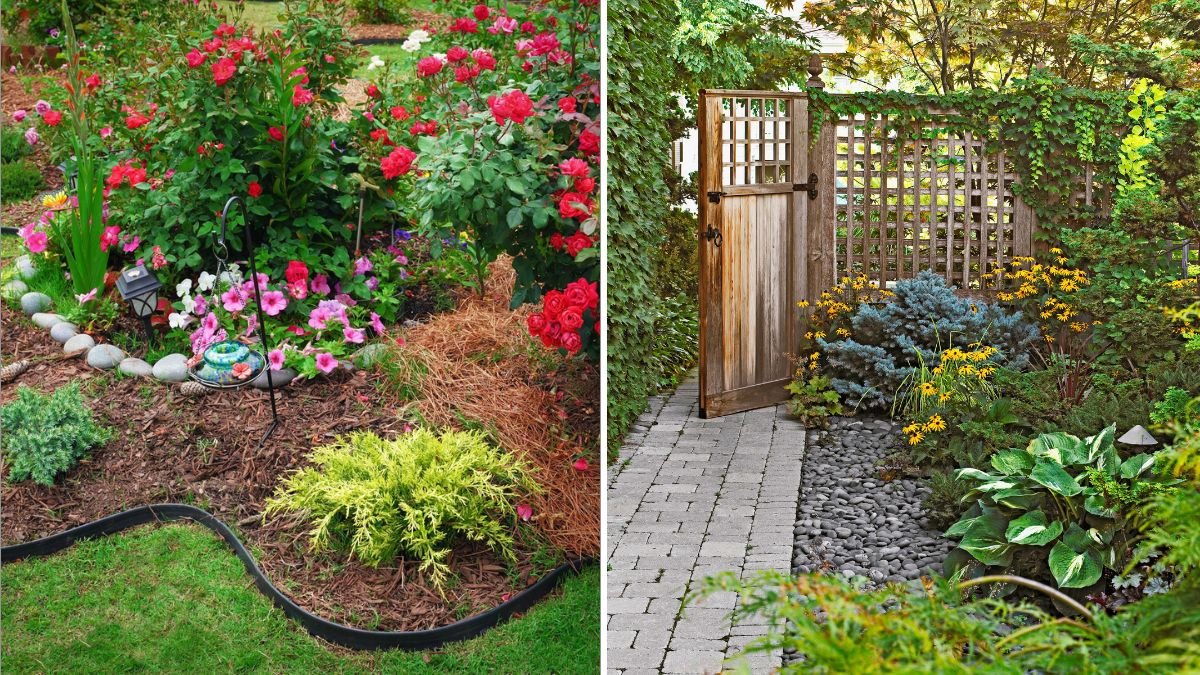Garden borders do more than just mark the edges of your flower beds—they define your entire landscape. A well-designed border can bring order to a wild garden, make your plants pop with contrast, and give your yard a clean, polished look that feels intentional and refined.
Whether your style is sleek and modern or rustic and natural, the right border can completely transform your outdoor space. Here are nine garden border ideas that not only frame your plants beautifully but also elevate the overall character of your yard.
1. Classic Brick Edging: Timeless and Versatile
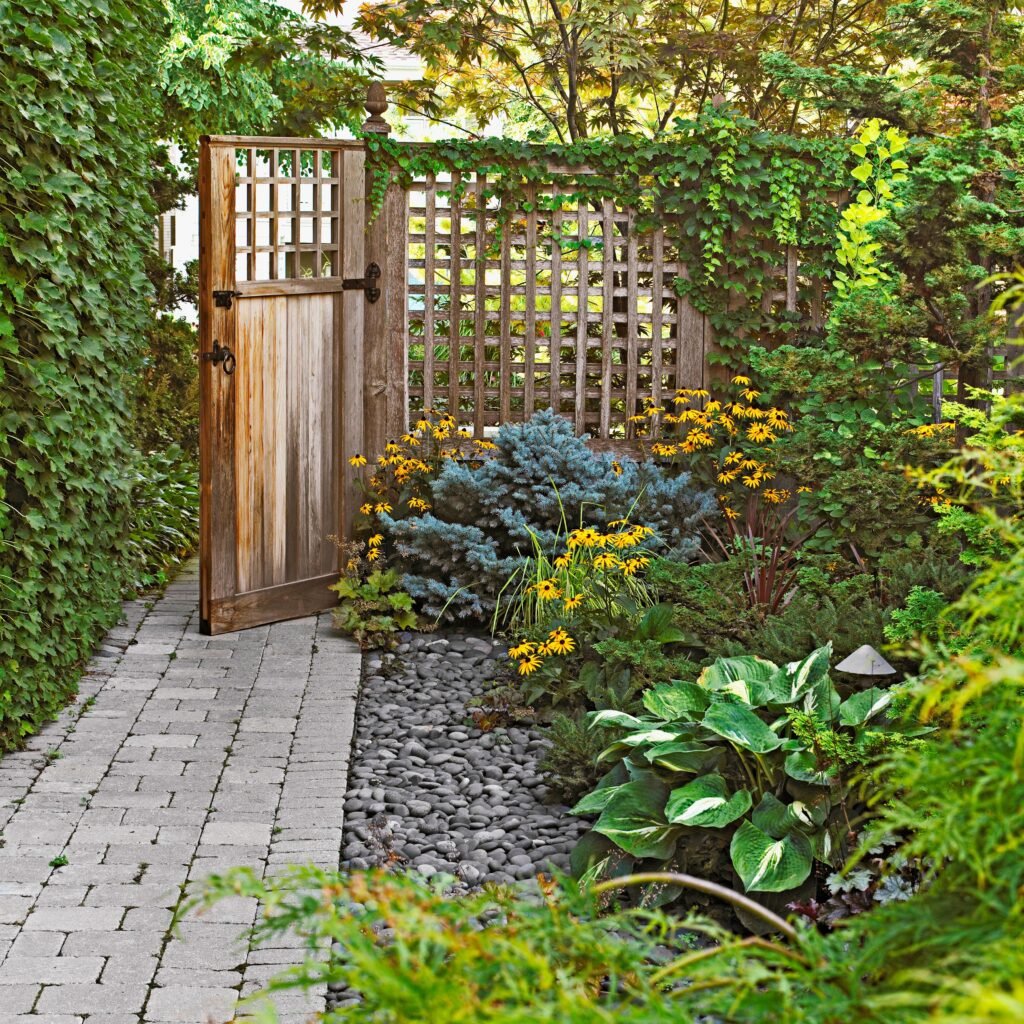
Brick is a favorite among gardeners for good reason—it’s durable, affordable, and works with almost any landscape style. The rich, earthy tones of brick provide a beautiful contrast against green lawns and colorful blooms.
Why it works:
- Creates a clean, structured edge that keeps grass from invading flower beds.
- Complements both traditional and contemporary home designs.
- Easy to maintain and withstands weather changes year-round.
Design tip:
Lay bricks flat for a low-profile edge, or angle them upright to create a raised, decorative line. For added charm, use reclaimed bricks for a slightly weathered, vintage look.
Best for:
Formal gardens, walkways, and lawns that need crisp definition.
2. Natural Stone Borders: Organic and Elegant
If you love a natural, cottage-style garden, few materials beat stone. Each piece of rock or flagstone adds character and variation, blending seamlessly with nature while still maintaining order.
Why it works:
- Creates a solid, permanent boundary that won’t shift easily.
- Works beautifully with perennials, shrubs, and ornamental grasses.
- Adds texture and a sense of timelessness to the landscape.
Design tip:
For a rustic aesthetic, use irregular fieldstones with uneven edges. For a more formal garden, choose neatly cut stones stacked evenly. Mix large and small rocks for a layered effect.
Best for:
Cottage gardens, sloped yards, and landscapes with natural terrain.
3. Metal Edging: Sleek, Minimal, and Durable
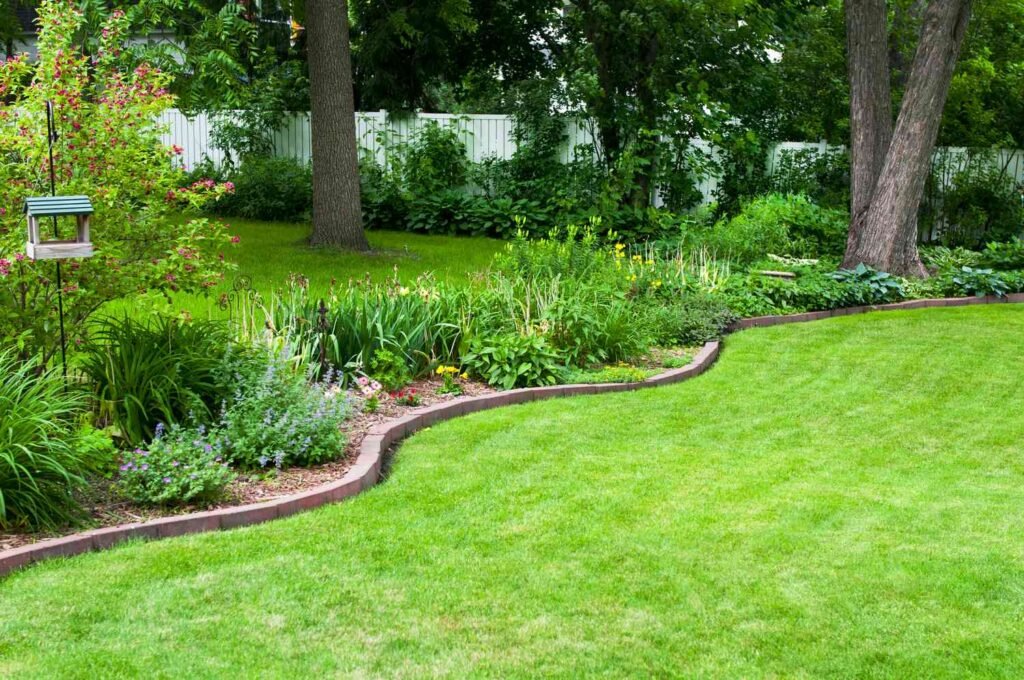
Modern landscapes benefit from the crisp, understated lines of metal edging. Materials like steel or aluminum offer a minimalist look that’s surprisingly low-maintenance.
Why it works:
- Keeps mulch, gravel, and soil neatly in place.
- Withstands moisture and won’t rot or crack like wood.
- Ideal for defining curves, paths, or geometric garden layouts.
Design tip:
Powder-coated steel in black or bronze adds an elegant touch, while corten steel develops a beautiful rustic patina over time. Install flush with the soil for a seamless, almost invisible finish.
Best for:
Modern, minimalist, or desert-style gardens.
4. Wooden Borders: Warm and Natural
Wood adds warmth and a handcrafted feel to any garden. It’s perfect for casual, natural landscapes or vegetable gardens where practicality matters as much as aesthetics.
Why it works:
- Inexpensive and easy to install.
- Adds a rustic charm and blends with most natural surroundings.
- Can double as a raised bed edge, helping to contain soil and compost.
Design tip:
Choose rot-resistant woods like cedar, redwood, or pressure-treated pine. Apply a weatherproof sealant annually to extend the wood’s lifespan. Try railroad ties or stacked timber for a bold, farmhouse-style statement.
Best for:
Vegetable patches, country gardens, or informal landscapes.
5. Concrete Borders: Strong, Clean, and Contemporary
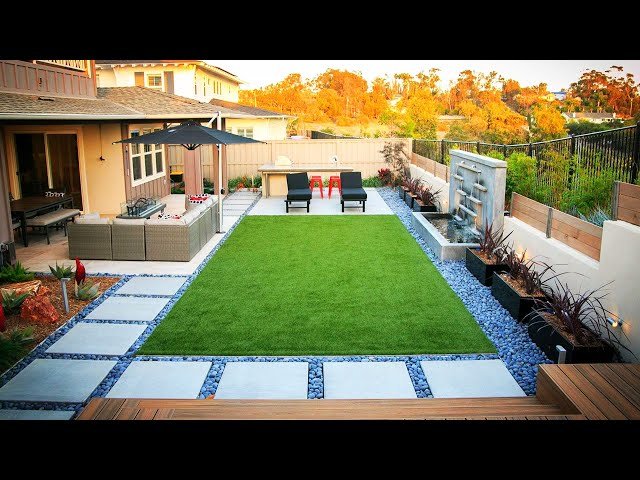
For long-lasting structure and a modern aesthetic, concrete edging is a top choice. It can be molded into straight lines or curves, offering complete design flexibility.
Why it works:
- Provides unbeatable durability—won’t rot, shift, or fade.
- Gives a clean, finished edge for modern gardens.
- Can be colored, stamped, or textured to resemble stone or tile.
Design tip:
For a sleek, architectural look, opt for poured-in-place concrete borders. If you prefer something more decorative, consider precast concrete blocks or pavers in contrasting shades.
Best for:
Contemporary homes, formal gardens, and driveways with a modern design.
6. Gravel or Pebble Edges: Soft and Low-Maintenance
Gravel and pebbles are fantastic for casual or drought-tolerant gardens. They offer a relaxed, natural edge that allows for good drainage and easy maintenance.
Why it works:
- Blends well with stone pathways or desert gardens.
- Helps prevent muddy patches and improves water flow.
- Available in a variety of colors and sizes for design flexibility.
Design tip:
Use metal or plastic edging to contain the gravel and prevent it from spreading into lawns. Combine different stone colors to create a layered, artistic look.
Best for:
Rock gardens, xeriscapes, and Mediterranean-style landscapes.
7. Living Borders: Green and Eco-Friendly
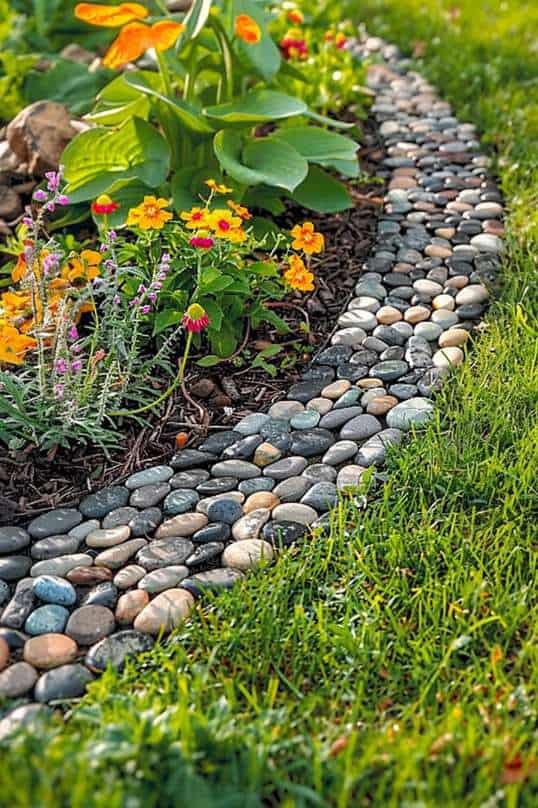
Instead of hard materials, try using plants as living borders. Low-growing perennials, herbs, or ornamental grasses can define edges while adding movement and color.
Why it works:
- Provides a soft, natural transition between lawn and flower beds.
- Enhances biodiversity by attracting pollinators and beneficial insects.
- Changes beautifully through the seasons, offering year-round interest.
Plant ideas:
- Lavender: Adds fragrance and a refined shape.
- Boxwood: Perfect for tidy, formal edges.
- Thyme or creeping Jenny: Great low-maintenance ground covers.
- Hostas or ornamental grasses: Add texture and lush greenery.
Design tip:
Trim regularly to maintain neat lines. For variety, alternate two or three plant types in repeating patterns for rhythm and visual harmony.
Best for:
Cottage gardens, herb gardens, and natural landscapes.
8. Recycled Materials: Creative and Eco-Conscious
If you love sustainable gardening or DIY projects, recycled materials can make stunning, one-of-a-kind garden borders. From wine bottles to reclaimed tiles, creativity has no limit.
Why it works:
- Environmentally friendly and budget-conscious.
- Adds a personalized, artistic flair to your garden.
- Great conversation starter and visual focal point.
Creative ideas:
- Old bricks or roof tiles: Lay them diagonally for a zigzag edge.
- Glass bottles: Invert and bury them neck-down in rows for color and sparkle.
- Reclaimed metal: Repurpose old pipes or corrugated panels for an industrial touch.
Design tip:
Mix materials thoughtfully to avoid clutter. Keep consistency in color or shape for balance.
Best for:
Eclectic, bohemian, or eco-friendly gardens with a creative edge.
9. Edging Plants with Pavers: Elegant and Functional
Pavers offer the perfect mix of structure and sophistication. Available in various materials like stone, brick, or concrete, they create a neat frame around lawns or beds while doubling as a mini walkway.
Why it works:
- Provides a professional, finished appearance.
- Prevents grass from creeping into flower beds.
- Versatile in shape—square, rectangular, or curved designs all work well.
Design tip:
Choose paver colors that complement your home’s exterior or garden theme. Use contrasting tones (like gray pavers around a green lawn) to highlight garden shapes. Seal them annually to prevent fading and moss buildup.
Best for:
Formal gardens, front yards, and symmetrical landscapes.
Bonus: Mixing and Matching for Texture and Contrast
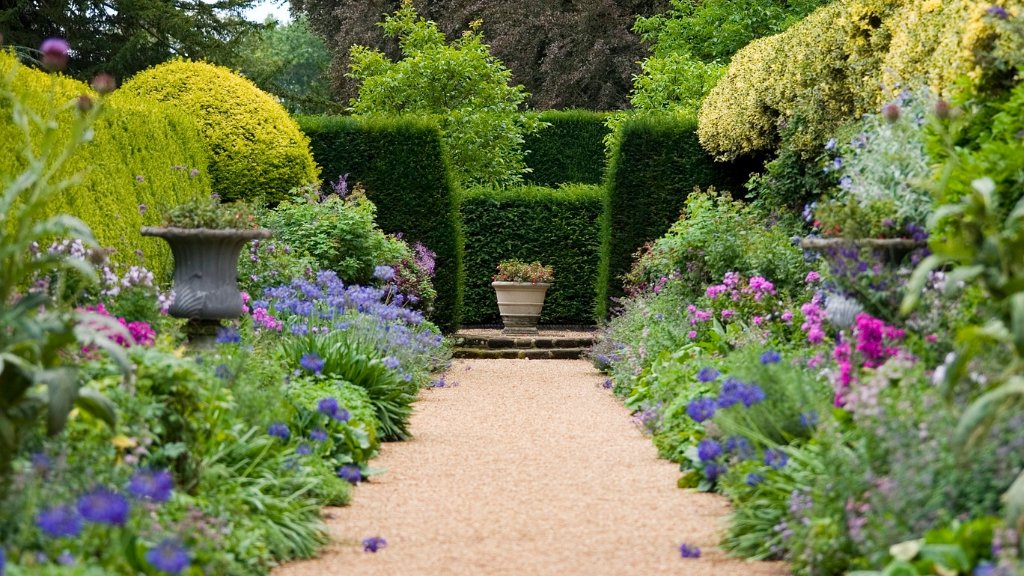
You don’t have to stick with just one material. Some of the most striking landscapes combine two or more edging types for visual depth. For example:
- Pair metal edging with gravel pathways for a modern look.
- Use brick edging alongside living borders for warmth and softness.
- Frame wooden raised beds with stone or pebble accents to add contrast.
This layered approach allows your garden to evolve naturally while maintaining structure.
Practical Tips for Installing Garden Borders
To get professional results, pay attention to these key installation steps:
- Plan your layout — Mark edges with string or spray paint before digging.
- Prepare the soil — Remove weeds, roots, and debris along the edge.
- Dig evenly — Keep trenches consistent in depth and width.
- Use edging materials properly — Secure stones or bricks with sand or mortar if needed.
- Add weed barriers — A strip of landscape fabric helps minimize unwanted growth.
- Maintain regularly — Check for shifting, weed growth, or weather damage.
A few hours of setup can save you months of maintenance later.
Final Thoughts
The right garden border is like the perfect frame for a painting—it brings structure, beauty, and focus to everything inside it. From timeless brick and stone to sleek metal and concrete, or even living plant borders, each option offers its own character and benefits.
When chosen thoughtfully, borders don’t just define your garden—they elevate your entire yard, giving it balance, charm, and a professional finish that lasts for years.
Whether you prefer a polished modern design or a soft, natural vibe, these nine garden border ideas can help you craft an outdoor space that’s as elegant as it is enduring.
